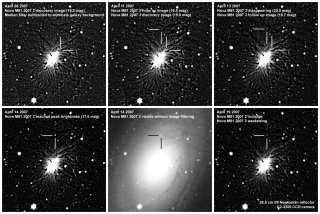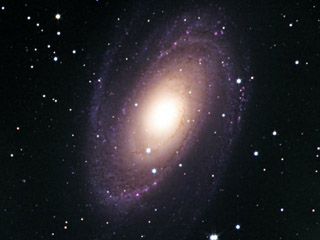|
What was intended to be simply a nice image of M81 galaxy, turned
to be a discovery image of extragalactic nova 12 millions light years
away. The 80 minutes long unfiltered exposure of M81, taken using
26.5 cm (10.4 inch)
Newtonian reflector and G2-3200 CCD camera on April 8th,
2007, showed a small blob very close to the galaxy core, just
35 arc seconds from the center. The blob was not clearly
shaped as a star, but this is rather normal because of complex
structures in the M81 bulge. No such blob could been visible on older
images, taken with much bigger scopes.

Images of the M81 novae taken with G2-3200 CCD
camera Nova discovery in M81 with only 10 inch telescope does not
sound very trustworthy. Maybe this was the reason why it was
impossible to get observing time on some bigger telescope to take
confirmation exposure. So we decided to take the follow-up image
ourselves. 120 minutes long exposure, taken on April
11th, 2007, clearly confirmed the blob on the previous
image was real—the
“M81 2007 2” was the first nova in M81 discovered
with such a small telescope. The nova weakened from
19.2 mag to 19.5 mag
within three days, which very well fitted the expected behavior.
To the big surprise of all team members, the follow-up image
contained another blob. It was farther from the galaxy core
(95 arc seconds) this time and it was shaped like a
19.9 mag star this time. While discovering nova
in M81 with small scope is not very probable, discovering two novae
within three days with the same scope definitely sounds like a
fantasy. All team members knew very well how easy is to consider
radiation event trace or hot pixel remnant to be a new star. But the
images were processed very carefully to eliminate all such artifacts.
And we had excellent comparison image, taken only three days earlier
with the same instrument.
The observing campaign was launched to proof both novae are real
and to follow their brightness curve. The second nova
“M81 2007 3” appeared to be quite extraordinary. It
reached absolute magnitude -10 mag on April 14th, 2007
and its apparent magnitude was 17.6 mag. It was
about 2 magnitudes brighter than expected.

M81 Boode's galaxy captured with G2-3200 CCD camera on
10 inch telescope Luckily Dr. Alex Filippenko and his team planned observations for
the night from April 14th to 15th on the
Keck I, the biggest telescope on Earth. He rearranged the
observing schedule and acquired spectra on the second nova. Bad seeing
prohibited his team to capture spectra of the first nova, which was
already quite weak. All results—coordinates,
magnitudes as well as reference to
Keck I observations—was published in
the electronic telegram IAU CBET No. 924.
Electronic Telegram No. 924
Central Bureau for Astronomical Telegrams
INTERNATIONAL ASTRONOMICAL UNION
M.S. 18, Smithsonian Astrophysical Observatory, Cambridge, MA 02138,
U.S.A.
IAUSUBS@CFA.HARVARD.EDU or FAX 617-495-7231 (subscriptions)
CBAT@CFA.HARVARD.EDU (science)
URL http://www.cfa.harvard.edu/iau/cbat.html
APPARENT NOVAE IN M81
K. Hornoch, Lelekovice, Czech Republic; and V. Pribik, P. Cagas,
and P. Cagas, Jr., Zlin, Czech Republic, report the discovery of
two possible novae in M81. The new objects were found on unfiltered,
co-added images (with typical total exposure time of 7200 s) taken by
P. Cagas with the 0.265-m telescope at Zlin Observatory. The first
object was discovered on Apr. 8.874 UT AND is located at R.A. =
9h55m28s.58, Decl. +69o04'21".6 (equinox 2000.0), which is 24".6 west
and 26".5 north of the center of M81. The second object was first
detected on Apr. 11.865 and is located at R.A. = 9h55m31s.30, Decl.
+69o05'28".9, which is 10".0 west and 93".8 north of the center of M81.
Available magnitudes for the first object by Hornoch (from
unfiltered CCD images, unless otherwise noted, using R-band magnitudes
from comparison stars): 2002 Dec. 24.184, [22.7 (2.54-m Isaac Newton
Telescope at La Palma; Sloan r-band); 2005 Nov. 6.266, [22.9 (4.2-m
William Herschel Telescope at La Palma; R-band); 2007 Jan. 24.302, [21.9
(P. Garnavich, 3.5-m WIYN telescope at Kitt Peak; R-band); Mar. 4.968,
[20.5 (K. Hornoch, 0.65-m reflector at Ondrejov, Czech Republic); Apr.
5.812, 19.0: (Hornoch, 0.65-m reflector at Ondrejov; prediscovery);
8.874, 19.2 (P. Cagas and P. Cagas, Jr., at Zlin); 11.865, 19.5 (Cagas);
12.909, 19.4 (V. Pribik, at Zlin); 13.932, 20.0: (Cagas and Cagas, Jr.);
14.858, 20.2: (Cagas).
Available magnitudes for the second object by Hornoch (as above):
2002 Dec. 24.184 UT, [22.7 (INT at La Palma; Sloan r-band); 2005 Jan.
8.517, [24.0 (8.3-m Subaru telescope at Mauna Kea; V-band ); 2005 Nov.
6.266, [23.0 (WHT at La Palma; R-band ); 2007 Jan. 24.302, [22.0 (P.
Garnavich, WIYN telescope; R-band); Mar. 4.968, [21.0 (K. Hornoch,
0.65-m telescope at Ondrejov); Apr. 5.812, [21.3 (Hornoch, 0.65-m
telescope at Ondrejov); 8.874, [21.0 (Cagas and Cagas, Jr.); 11.865,
19.9 (Cagas); 12.909, 19.2 (Pribik); 13.932, 18.7 (Cagas and Cagas, Jr.);
14.858, 17.6 (Cagas); 14.917, 17.7 (Hornoch, 0.35-m reflector at
Lelekovice); 14.989, 17.7 (Hornoch, 0.35-m reflector at Lelekovice).
Note that raw images from the INT and WHT were obtained from the ING
archive, and images from the Subaru telescope were obtained from the
SMOKA Science Archive.
J. M. Silverman, R. J. Foley, and A. V. Filippenko, University of
California, Berkeley, report that inspection of relatively-low-quality
CCD spectra (range 330-920 nm), obtained of the second (brighter)
apparent nova described above on Apr. 15 UT with the Keck I 10-m
telescope (+ LRIS), shows a nearly featureless blue continuum with wide
(FWHM = 940 km/s) H-alpha absorption. After removing the host galaxy's
velocity of -34 km/s (de Vaucouleurs et al. 1991, Third Ref. Catalogue
of Bright Galaxies, Version 3.9), the minimum of the H-alpha absorption
is found to be blueshifted by 870 km/s.
NOTE: These 'Central Bureau Electronic Telegrams' are sometimes
superseded by text appearing later in the printed IAU Circulars.
(C) Copyright 2007 CBAT
2007 April 15 (CBET 924) Daniel W. E. Green
Another observations of “M81 2007 3” by the
Keck I LRIS spectroscope and photometric observations on
60 inch telescope on Mt. Palomar was performed by A. Rau, S.
Gezari, E. Ofek (Caltech) and published in the ATel #1067.
It was definitely en exciting campaign, during which the
10 inch scope discoveries were followed by 10 meter
telescope. The “M81 2007 3” nova was the brightest
one ever discovered in M81. And 10 inch telescope is by far the
smallest instrument used to discover nova so far away. G2 CCD cameras
proved to be research-grade devices, turning even small telescope into
discovery instrument. And the old saying “There is a science in
every astronomical image” once again proved to be true.
Team members participating on this campaign were: Kamil Hornoch,
Vaclav Pribik, Petr Cagas and Pavel Cagas.
References:
| 